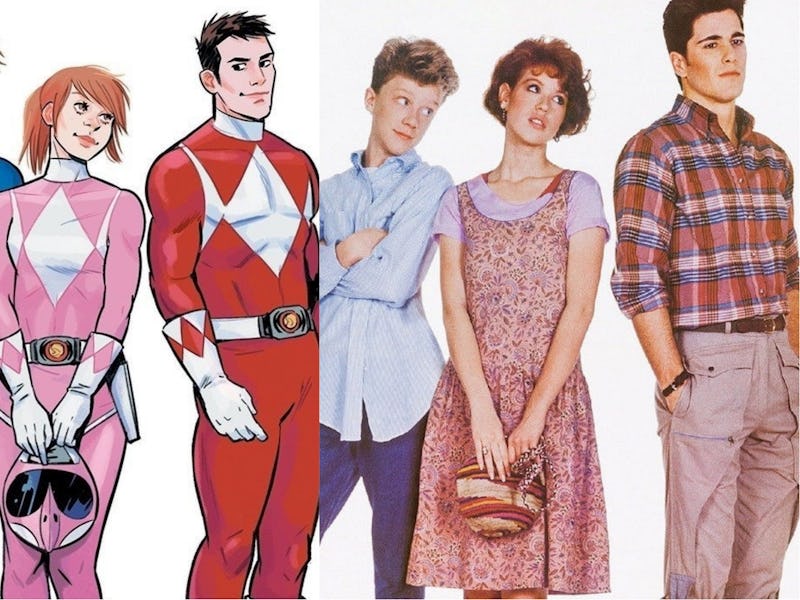Why 'Go Go Power Rangers' Comic Looks Like a John Hughes Movie
Those teen movie variant covers are more than just nostalgia, says comic book writer Ryan Parrot.

You can’t judge a book by its cover, but some book covers tell a story on their own. Take the covers for Go Go Power Rangers, the BOOM! Studios comic book series.
In an ongoing series of variant covers — alternate versions of covers of individual comics that encourage collecting — illustrators Natasha Bustos and Dylan Todd pay homage to the coming-of-age movies of the ‘80s and ‘90s, including Sixteen Candles, Footloose, Pretty in Pink, Heathers, Risky Business, and Mallrats.
In an interview with Inverse at Power Morphicon, series author Ryan Parrot says the covers are more than just millennial nostalgia; they signal to anybody who sees them the tone of the story within.
“Who doesn’t want to make John Hughes versions of the Power Rangers?,” he adds.
Launched in 2017, Go Go Power Rangers is a prequel to BOOM!’s ambitious Mighty Morphin Power Rangers series by Kyle Higgins. Whereas Mighty Morphin is a blockbuster series steeped in mythology and sci-fi — not to mention the main stage on which Shattered Grid was told — Go Go concentrates on the personal #drama of five teens who happen to be superheroes.
“It feels like all the responsibilities you had in high school was so monumental. For these people it actually is,” Parrot says. “So I use that as a metaphor for how people feel growing up.”
Variant cover of 'Go Go Power Rangers' #1.
Other influences on the comic include Brian Michael Bendis’ Ultimate Spider-Man and Joss Whedon’s Buffy the Vampire Slayer. (“Buffy played the truth of emotion, it would take all the normal problems you had in high school and manifest them as monsters,” he says.) But for Parrot, the biggest influence was the real life breakup of his group of best friends that revealed to him just how fragile young people’s lives can be.
At the same time Mighty Morphin Power Rangers was on the air, Parrot was in high school when his district split in half after a new public school opened. “We thought we were going to high school together,” Parrot remembers. “And then half my friends went to one high school, the other half went to another.”
Before social media, a radical change like this was enough to ravage one’s social circle. “Slowly over time we got pulled farther apart,” the writer recalls. Years later, in writing Go Go, this experience shaped Parrot’s main story storyline of the comic: Matt, the “forgotten friend” of Jason, Kimberly, Billy, Zack, and Trini whom Zordon didn’t recruit to fight Rita Repulsa.
Cover of 'Go Go Power Rangers' #3, with Zack the Black Ranger on the poster for 1984's 'Footloose.'
“What if Matt was part of this group, and those five five got pulled into a ‘high school’ they could never tell him about?” Parrot explains. “My five best friend change the subject whenever I walk into a room. What happened? I thought there was a lot of reality. That’s what high school’s about.”
With twelve issues down, Parrot is looking ahead to “Year 2” of Go Go Power Rangers (which he says will continue to take place before the events of Higgins’ Mighty Morphin sesries). At Power Morphicon, BOOM! Studios unveiled a big, exciting change to the Power Rangers: a “color switch” that will see Trini take lead as the Red Ranger. The whole team is getting new colors, in fact.
“Coming out of Shattered Grid, we’re dealing with the emotional consequences of the Ranger Slayer’s travel into the past and what it’s done to our group of friends, all six of them,” Parrot tells Inverse a few weeks after Power Morphicon in a phone call. While Rita Repulsa embarks on an “intergalactic road trip” for a super secret weapon, the Power Rangers will switch colors in what Parrot calls a “character study.”
“I wanted to explore this idea: Does character dictate their color, or does color dictate their character? This was an opportunity to dig into who these characters are and tell a small story about them.”
The next issue, Go Go Power Rangers: Back to School#1, a one-shot special, will be released on September 13.